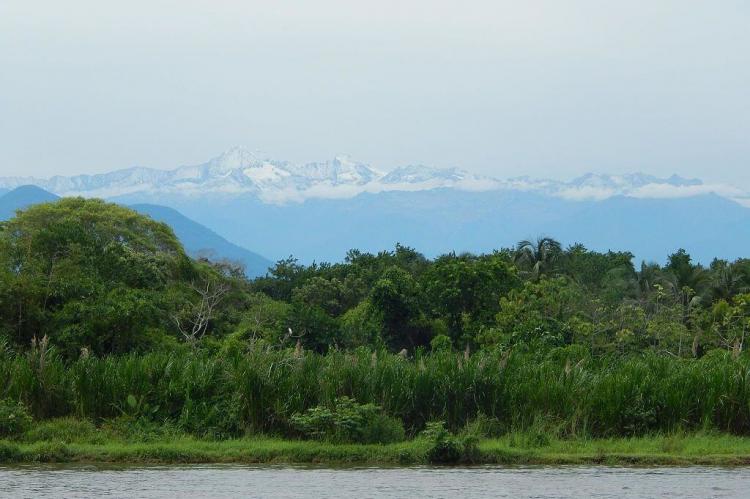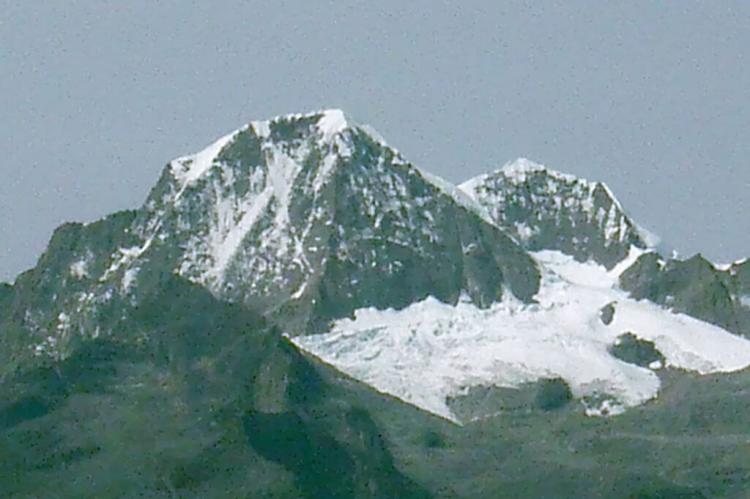Sierra Nevada de Santa Marta (Colombia)
The Sierra Nevada de Santa Marta is an isolated mountain range, separated from the Andes chain, that runs through Colombia. It is one of the world's highest coastal ranges, situated near the Caribbean coast, culminating in the snow-capped Cristóbal Colón, Colombia's highest peak.
Sierra Nevada de Santa Marta
The Sierra Nevada de Santa Marta is an isolated mountain range, separated from the Andes chain that runs through Colombia. The range is bounded on the north by the Caribbean Sea and encircled on three sides by the coastal lowlands.
Reaching an altitude of 5,700 m (18,700 ft) just 42 km (26 mi) from the Caribbean coast, the Sierra Nevada de Santa Marta is one of the world's highest coastal ranges. The volcanic massif rises abruptly from the coast, culminating in the snow-capped Cristóbal Colón, the highest peak in Colombia.
The Sierra Nevada de Santa Marta National Natural Park, the Tayrona National Natural Park, and the Sierra Nevada de Santa Marta Biosphere Reserve are protected areas.
The area is home to the remnants of the Native American Tairona Culture, Arhuacos, Koguis, Wiwas, and Kankuamos, that live in Resguardos Indigenas (Indian reserves) in the mid-highlands.
The lower slopes of the Sierra Nevada de Santa Marta are used for agriculture and livestock raising, but the region is not well developed. The local population includes Arawak Indians. The indigenous peoples made an alcoholic beverage from fruits of the palm Attalea maripa found at the lower elevations.
The tropical rainforest comprises perennial trees with a canopy between 30 m (98 ft) and 40 m (130 ft). There is a great variety and large populations of epiphytes and lianas, and more than 3,000 species of vascular plants are found in the area.
Of Colombia's 340 endemic species, 44 are found in the park, for example, seven species of endemic hummingbirds. Of the 3,057 endangered species, 44 are found here.
The area is home to 440 species of birds, including black-fronted wood-quail, king vulture, Andean condor, Santa Marta warbler and Santa Marta parakeet.
Mammals include tapir, cougar, jaguar, squirrel, Transandinomys talamancae, otter, and brocket deer.
Ecoregions
The Sierra Nevada de Santa Marta is home to several ecoregions, which vary with elevation.
-
The Guajira-Barranquilla xeric scrub region lies near the Caribbean seacoast to the north of the range.
-
The Sinú Valley dry forests cover the range's lower slopes up to an elevation of 500 m (1,600 ft).
-
The Santa Marta montane forests lie above 500 m (1,600 ft) to 800 m (2,600 ft). The montane forests are separated from other moist forests by the lower-elevation dry forests and xeric shrublands and have large numbers of endemic species. The montane forest ecoregion has several distinct plant communities distinguished by altitude and rainfall.
-
Moist lowland forests cover the windward northern and western flanks of the range between 500 m (1,600 ft) and 900 m (3,000 ft) and the drier eastern and southern flanks from 5,800 m (19,000 ft) to 1,000 m (3,300 ft).
-
Above 900 m (3,000 ft) is a transitional forest zone of smaller trees and palms.
-
Cloud forests occur above 1,000 m (3,300 ft).
-
The Sub-Andean forests, from 1,000 m (3,300 ft) to 2,500 m (8,200 ft), form a canopy 25 m (82 ft) to 35 m (115 ft) tall.
-
The higher-elevation Andean forests, between 2,500 m (8,200 ft) and 3,300 m (10,800 ft), grow to 15 m (49 ft) to 20 m (66 ft) in height.
-
The Santa Marta Páramo, a high-altitude belt of montane grasslands and shrublands interspersed with marshes and acid bogs, occupies a zone between 3,300 m (10,800 ft) and 5,000 m (16,000 ft). The Santa Marta Páramo is the northernmost enclave of Páramo in South America, which occur along the Andes belt.
-
Above 5,000 m (16,000 ft) lies the permanent snow cap.

